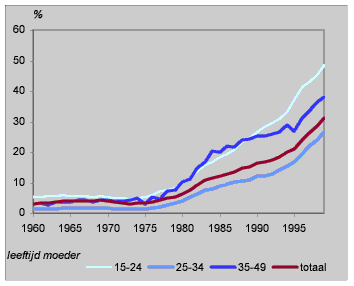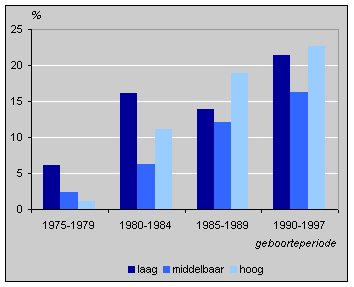More and more children born outside marriage

The number of extra-marital births in the Netherlands rose from 3,000 to just over 50,000 between 1960 and 2000. Two-thirds of these babies are first births. While one in thirty Dutch first children were born out of wedlock in 1960, this number was one in three last year.
However, there is one great difference with the past in this respect. Today, babies born to unmarried mothers are born within a relationship, usually to a couple who have made a conscious choice for a child. In the nineteen-sixties these ‘illegitimate’ births were often to young single women who had not planned to become pregnant.
Mainly younger and older women
Relatively many women who have their first baby at a young age are unmarried. Until the mid seventies fewer than 10% of children of 15-24 year-old mothers were born out of wedlock. This proportion has now risen to nearly half of children of mothers in this age group.
The share of unmarried births among 25-34 year-old mothers is much lower. But for the older age group – mothers who have their first baby after 34 years of age - the proportion of extra-marital births rises again.
Extra-marital first births as a percentage of all first births

Lower and higher educational levels
The attained level of education is also an important factor in extra marital birth rates. At the end of the seventies and the beginning of the eighties, extra marital births were most common among – often single - women with a low level of education.
In the eighties women with higher levels of education also started having children without getting married first. These were the women who pioneered unmarried cohabitation as a new relationship form. Only later did women with lower and intermediate levels of education follow their example and live together with their partners without being married. This pushed up the number of babies born out of wedlock.
Extra-marital first births as a percentage of all first births by mother’s level of education

Maarten Alders and Arie de Graaf